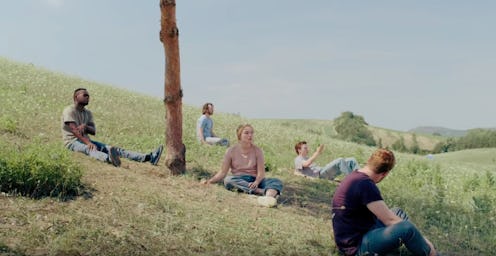Entertainment
How ‘Midsommar’ Erected An Authentic Swedish Village In A Totally Different Country
In Midsommar, what starts off as a harmless trip to a village in Sweden for a cultural festival turns into a living nightmare. The film's setting is vitally important to the story, but you won't find the location where the fictional commune was created anywhere in Sweden. Instead, Midsommar was filmed in Hungary, outside of the city Budapest, where the rolling hills loom over the seemingly innocuous proceedings.
Midsommar, out July 3, follows a group of students including Dani (Florence Pugh) and her boyfriend Christian (Jack Reynor), guided by their Swedish friend, Pelle (Vilhelm Blomgren). He was born and raised in the village called Hårga, and wants to show his friends his community and the once-in-a-lifetime festival they're celebrating. Hårga is in a vibrant, bucolic field that's of great importance to the people who live there, as the members of the cultish commune lives off the land.
The reason for the change in filming location is shockingly reasonable for a film with a warped sense of reality. Midsommar was filmed in a different country because of a Swedish law that restricts film crews from shooting for more than eight hours per day, according to the film's production notes.
Hälsingland, the province where Midsommar takes place, is a real location you can visit if you ever go to Sweden. And there's also a real village called Hårga. But if you make it there, you won't find a vast field dotted with strange, triangular structures.
Filmmaker Ari Aster and production designer Henrik Svensson brought Scandinavian culture — and then some — to their filming location in the countryside outside of Budapest. They also built the entire town from scratch over the course of two months, according to the notes. To make the film even more authentic, Aster also cast Swedish actors as the Hårga villagers and flew them to Hungary for the shoot.
"We tried to get a grasp on how people in rural and religious Scandinavian communities lived, from 500 years ago up until the present day," Svensson says in the notes. "We looked at the natural elements — how people took care of nature, including plants and animals—as well as the structural elements and the art that surrounded them, including wall paintings. Culture is very strong in these parts, we wanted to get a sense of how they communicated, which was more often than not through music."
Aster and Svensson based the murals adorning the walls of some of those buildings on real medieval paintings they saw on scouting trips in Hälsingland. The murals add another element of intrigue to the film that's easily missed with an initial viewing. "Hidden inside these paintings is everything that’s going to happen in the movie without giving viewers any obvious signs," Aster says.
The experience of filming on such a comprehensive set affected the actors too. "Every day we stepped into that field we were stepping into the world of Hårga," Pugh says in the notes. "It was hugely exhilarating and helpful to be living amongst it all and made the experience even more eerie." They were able to immerse themselves into the setting, seeing even more detail than viewers will be able to catch — at least in one sitting. "Often we would wander off in between takes and just stare at the artwork on the walls," Pugh says.
Under the harsh sun of the Hungarian countryside, the unsettling practices of the Hårga people are brought to light. Even without a Swedish location, the Midsommar creative team certainly succeeded in making its fictionalized Hårga a specific, tangible, place.
